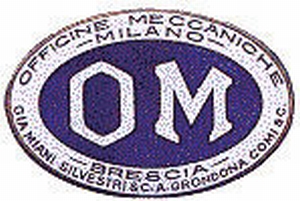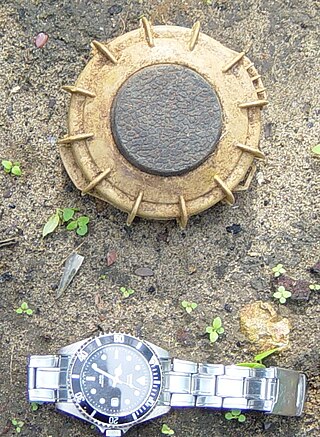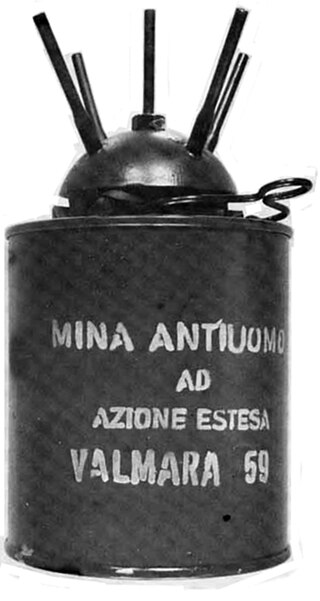Related Research Articles

A land mine, or landmine, is an explosive weapon concealed under or camouflaged on the ground, and designed to destroy or disable enemy targets, ranging from combatants to vehicles and tanks, as they pass over or near it.

Officine Meccaniche or OM was an Italian car and truck manufacturing company. It was founded in 1899 in Milan as Società Anonima Officine Meccaniche to manufacture railway rolling stock and car production began in 1918. It disappeared as such in 1975, subsumed into Iveco, but still exists as a forklift builder.

Valmara 69 or V-69 is an Italian bounding anti-personnel mine manufactured by Valsella. The mine was developed from the V-59 mine, and although the mine is no longer produced in Italy, a number of copies were produced in other countries e.g. the "SPM-1" manufactured by Singapore.

The M16 mine is a United States-made bounding anti-personnel mine. It was based on captured plans of the World War II era German S-mine and has similar performance.
The SB-33 is a small Italian minimum metal blast type anti-personnel mine formerly manufactured by Misar, that entered service in 1977. The SB-33 can be emplaced by hand or scattered using the helicopter mounted SY-AT system.

The PROM-1 is a Yugoslavian manufactured bounding anti-personnel mine. It consists of a cylindrical body with a pronged fuze inserted into the top of the mine. It is broadly similar in operation to the German S-mine.

The VS-MK-2 is a plastic bodied scatterable anti-personnel blast mine manufactured by the now-defunct Valsella Meccanotecnica, SpA, an Italian high-tech defence contractor that specialized in the development and production of area denial systems. The mine is extremely difficult to detect because of its low metal content i.e. it is a minimum metal mine. Additionally, it is resistant to blast overpressure due to a pneumatic system in the fuze. The mine will also function in up to 1 metre of water. An electrically fused anti-handling version of the mine was also produced designated VS-MK-2-EL, VS-MK-2-E or VS-MK2 AR-AN to hinder clearance attempts. Although Italy has ceased production of this mine it may still be found in uncleared minefields located in Angola, Sudan and the Western Sahara.

The VS-50 is a circular plastic-cased anti-personnel blast mine that entered production in 1985. It was formerly made by the now-defunct Valsella Meccanotecnica SpA, an Italian high-tech defence company specialized in area denial systems. The company also the made the Valmara 69, and was one of the first to implement plastic construction for landmines. The VS-50's design is similar to that of the TS-50 and VS-MK2 mines. It is blast resistant and can be used in a minimum metal configuration. Though unlikely to kill, its explosive charge is quite sufficient to destroy the victim's foot, being capable of penetrating 5 mm of mild steel leaving an 80 mm-diameter hole.

A minimum metal mine is a land mine that is designed to use the smallest amount of metal possible in its construction. Typically, the only metal components are located inside the fuze mechanism which triggers detonation. Both minimum metal anti-tank and anti-personnel mines exist. Some designs contain virtually no metal at all, e.g., less than a gram.

A blast resistant mine is a landmine with a fuze which is designed to be insensitive to the shock wave from a nearby explosion. This feature makes it difficult or impossible to clear such mines using explosive minefield breaching techniques. As a result, the process of clearing minefields is slower and more complex. Blast resistance can be achieved in a number of ways.

The Valmara 59 is a large cylindrical Italian bounding anti-personnel mine. It is the first in the "Valmara" family of mines produced by Valsella Meccanotecnica, and was followed by the Valmara 69 and VS-JAP. The mine's body is plastic with a distinctive five-pronged metal head. The central prong has a hole, to allow the threading a trip wire. The inner body of the mine has a main charge surrounded with approximately 1,000 steel cubes, below which is a steel wire connecting it to the base of the mine. When the mine is triggered a small charge launches the mine into the air approximately 45 cm before the steel wire is pulled taut, the jolt of which pulls a striker into the detonator. A secondary time fuse triggers the mine after three seconds if it has not detonated after being triggered.

The VS-JAP is an Italian bounding anti-personnel mine. It is the latest of the Valmara family of bounding mines that includes the Valmara 59 and Valmara 69. The mine has a waterproof plastic faceted cylindrical body with a three-pronged cap, with a central fixing point for a tripwire. The fuze is triggered via downward or sideways pressure.
The P-25 is a plastic cased Italian anti-personnel stake mine. It was developed along with the larger P-40 mine in the late 1970s by Misar SpA and entered production in 1978. The mine consists of a plastic cylinder with a fuse protruding from the top. The mine can either be stake mounted or buried, although it was designed to be stake mounted. Pull pressure on the tripwire results in the fuse head tilting sideways, releasing a striker into the detonator assembly.
The VAR/40, VAR/100 and VAR/100/SP are Italian anti-personnel blast landmines produced by the Tecnovar italiana S.p.A. company.
The BM/85 is an Italian blast resistant bounding anti-personnel mine that was produced by Tecnovar italiana SpA. The mine is cylindrical with a three pronged tilt/pressure fuze on the top with a central post for attaching a tripwire. A plastic safety clip prevents the fuze from tilting when in transit. Once the pressure clip is removed the mine is armed. Once the fuze is pulled sideways by a trip wire or by downward pressure, the mine is triggered. A small charge launches the mine to a height of about 0.45 meters where it explodes scattering 1,000 fragments to a lethal radius of about 25 meters.

The TS-50 is a 90 mm (3.5 in) diameter circular Italian blast resistant minimum metal anti-personnel mine designed and produced by Valsella Meccanotecnica (Italy).
Italy provided substantial supplies to Iraq during the Iran–Iraq War. Its greatest impact, however, was financial, with the U.S. branch of the state-owned, largest bank, Banca Nazionale del Lavoro (BNL) in Italy providing several billion dollars in funding for Iraqi military procurement. Italy also was a primary supplier to the Iraqi nuclear program, although that was not of direct effect on the Iran–Iraq War.
Singapore, a major commercial hub with loose export controls on weapons, both served as a transshipment point for weapons destined for Iraq, as well as providing chemical warfare precursors and being a site for manufacture, under license, of foreign-designed weapons.
Leonardo Sistemi di Difesa is an Italian defense company part of the Leonardo conglomerate.
References
- ↑ Landmine monitor report, International Campaign to Ban Landmines, pg 721
- ↑ Zeiske, Kathrin (7 October 2009). "Krieg ist ein perverses Geschäft" [War is a perverted business]. Neues Deutschland.
- ↑ "Unknown". Archived from the original on 20 July 2011.
- ↑ "ITALY: Mine Ban Policy". Landmine & Cluster Munition Monitor. International Campaign to Ban Landmines. Retrieved 19 October 2012.
Misar's land and sea mine production line was sold to Societa Esplosivi Industriali (SEI), which is now controlled by the Paris-based Societe Anonyme d'Explosifs de Produit Chimique (SAEPC).
- ↑ S.E.I. Società Esplosivi Industriali S. p. A. "MISAR". Legal Force. Trademarkia.com.
{{cite web}}: Missing or empty|url=(help) - ↑ "Un Impero Cresciuto Con La Guerra" [An Empire Grown with the War]. La Repubblica. Milan. 11 March 1988. Retrieved 19 October 2012.
- ↑ Schmetzer, Uli (17 August 1987). "Mine Sales Draw Italian Inquiry". Chicago Tribune. Rome.
- ↑ "Nove Milioni di Mine a Saddam" [Nine Million Mines to Saddam]. La Repubblica. 12 February 1991. Retrieved 19 October 2012.
- ↑ Blackhurst, Chris (18 November 1993). "Tobacco firm accused of Iraqi arms deal: French TV programme alleges mysterious international company was key player in shipment of 9 million anti-personnel mines, which were used in the Gulf War" . Retrieved 19 October 2012.
- ↑ "Unknown (registration required, in Italian)". L'Unione Sarda.